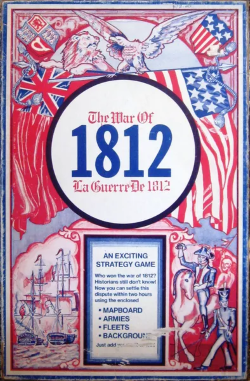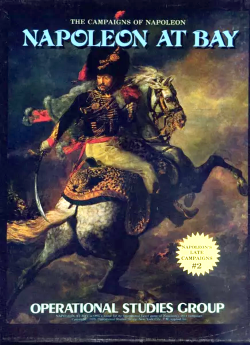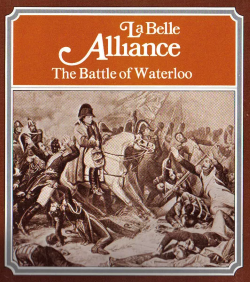
Napoleon, subtitled "The Waterloo Campaign, 1815", is a strategic-level block wargame published by Gamma Two Games in 1974 that simulates the Battle of Waterloo. A number of versions of the game have been produced by Avalon Hill and Columbia Games.

Napoleon, subtitled "The Waterloo Campaign, 1815", is a strategic-level block wargame published by Gamma Two Games in 1974 that simulates the Battle of Waterloo. A number of versions of the game have been produced by Avalon Hill and Columbia Games.
Instead of cardboard counters, military units are represented by square blocks. The blocks are marked on one side by the unit designation; at the start of the game, these face away from the opposing player so that their exact designation is unknown, simulating the "fog of war." [1]
With three armies in play (French, British & allies, and Prussian) the game can be played by either two or three players. [1] The main board shows the area of the battle. When units come into contact, the combat is moved to a smaller board for resolution. [2]
The number of blocks has varied from edition to edition:
The game also has two mapboards and a rule book.
The game uses an alternating system of turns where the French move and fire, representing the morning of the battle; followed by a British and Prussian turn, representing mid-day; and the French have the third turn, representing the evening.
The map does not have a traditional hex grid but instead uses areas and towns connected by a network of roads. Movement along major roads is faster than on minor roads or across bridges. [4] Units must be concentrated into groups, and each player can only move two groups per turn. [4]
All units start with their block turned so that their highest combat value (CV) is at 12 o'clock. The French player forms their blocks into three columns, and then the British/Prussian player does the same. Both players then lay down their blocks so that the units and current CVs are revealed. Each column will fight the column in line with it. The combat sequence is: [5]
The Attacker then goes through these same phases. This sequence of play is repeated until one army is eliminated, or one player decides to retreat. If a player retreats, the non-retreating army's reserve units triple their CV and fire one final volley. [6]

In 1972, Tom Dalgliesh co-founded Gamma Two Games and designed the first block wargame, Quebec 1759 . [7] That game was a success, and Dalgliesh designed War of 1812 in 1973, and Napoleon: The Waterloo Campaign, 1815 in 1974.
These three games were the first block wargames, where units are represented by wooden or plastic blocks rather than the more traditional miniature soldiers or die-cut cardboard counters. [1]
Gamma Two immediately re-issued the game later in 1974 that used cover art based on the famous painting Napoleon Crossing the Alps by Jacques-Louis David.
Gamma Two sold the rights to Napoleon to Avalon Hill, which produced a second edition of the game in 1977 using the same cover art.
After Avalon Hill's demise, Gamma Two Games — by then Columbia Games — took back the license and produced a third edition in 1994 and a fourth edition in 2013. [3]
In the 1980 book The Complete Book of Wargames , game designer Jon Freeman commented "Napoleon is a fresh experience for the land-combat enthusiast. Although it doesn't resemble a simulation very much, it is a challenging game that can be fun to play." He noted that luck plays a part in the game, saying, "The vagaries of the dice produce scrambling, tension filled battles in which a decisive defeat can be turned into victory in an amazingly short time." Freeman gave this game an Overall Evaluation of "Good to Very Good", concluding, "The real emphasis is on concentrating sufficient force to overcome any freak occurrence. It's a refreshing break from the rigors and eyestrain of more conventional treatments." [4]
In Issue 24 of Fire & Movement , Bill Haggart conceded that "If this [game] sounds like Risk more than simulation gaming, that is correct in many ways; Napoleon is that simple. Nevertheless, Napoleon does simulate certain aspects pof Napoleonic warfare better than any other game." Haggart conlcuded, "The game system forces the players to think in terms of 'space-time,' that is, envisage a series of marches culminating in a battle at a point where the enemy can neither win nor afford to retreat." [8]
In Issue 13 of Paper Wars , Jonathan Price noted, "Unlike other wargames, Napoleon rarely playes alike twice. With the ability to establish one's own initial deployment and the myriad of moves available from this, each game plays fresh almost every time." [9]
In Issue 52 of Moves , Ian Chadwick wrote, "It is good for a few quick games, and the outcome is hard to predict since the dice play such a large part in combat. It is a lot of fun to play every now and then, though continuous play becomes tedious and you ache for more substance." Chadwick gave the game an "A" for playability, a "C-" for historical accuracy and a "B" for component quality, concluding, "This is the best of the three similar games produced by Gamma Two and the most balanced of the lot. It is a good way to break reluctant friends into the hobby." [10]

Columbia Games is one of the oldest manufacturers of board wargames, and has also produced the Hârn role-playing game as well as various card games and collectible card games. Their wargames are notable for using small wooden or plastic blocks instead of the more conventional cardboard counters. The company, originally titled Gamma Two Games, started in Vancouver, Canada, but after ten years changed its name to Columbia Games, and eventually moved to Blaine, Washington. It is currently run by founder Tom Dalgliesh and his son Grant.

Battle of the Bulge is a board wargame published by Avalon Hill (AH) in 1965 that simulates the World War II battle of the same name. General Anthony McAuliffe (ret.), who had been commanding officer at Bastogne during the Battle of the Bulge, was a consultant during the game's development. The game proved popular and sold more than 120,000 copies, but was dogged by criticisms of historical inaccuracies, and was finally replaced by a completely new edition in 1981. A third edition in 1991 was released as part of the Smithsonian American History Series.

A block wargame is a board wargame that represents military units using wooden blocks instead of cardboard counters or metal/plastic miniatures.

Stalingrad is a strategic-level board wargame published by Avalon Hill in 1963 that simulates the first 24 months of the war between Germany and the Soviet Union during World War II. As one of the first board wargames it was extensively played and discussed during the early years of the wargaming hobby.

A board wargame is a wargame with a set playing surface or board, as opposed to being played on a computer or in a more free-form playing area as in miniatures games. The modern, commercial wargaming hobby developed in 1954 following the publication and commercial success of Tactics. The board wargaming hobby continues to enjoy a sizeable following, with a number of game publishers and gaming conventions dedicated to the hobby both in the English-speaking world and further afield.

War and Peace, subtitled Game of the Napoleonic Wars: 1805–1815, is a board wargame published by Avalon Hill in 1980 that simulates ten years of Napoleonic wars.

War of 1812, subtitled in the first edition "La Guerre de 1812", is a board wargame published in 1973 by Gamma Two Games,, that simulates the War of 1812.

Arcola, The Battle for Italy 1796 is a board wargame published by Operational Studies Group (OSG) in 1979 and republished by Avalon Hill in 1983 that is a simulation of the Battle of Arcola between French and Austrian forces in 1796. The game was designed to tempt players to purchase OSG's previously published and larger wargame Napoleon in Italy.

EastFront, subtitled "The War in Russia: 1941–45", is a board wargame published by Columbia Games in 1991 that is simulation of the conflict between Germany and the Soviet Union during World War II.

Napoleon at Bay, subtitled "Prelude to Waterloo: The Campaign in France, 1814", is a board wargame published by Tactical Studies Group/Operational Studies Group in 1978 that is a simulation of Napoleon's attempts to keep the Allies out of Paris in the early months of 1814.

Quebec 1759 is a board wargame published in 1972 by Gamma Two Games that simulates the Battle of the Plains of Abraham outside the walls of Quebec in 1759. The game uses wooden blocks set on their edge rather than the more traditional cardboard counters, unique for a wargame in 1972.

Napoleon at War, subtitled "Four Battles", is a collection of four board wargames published by Simulations Publications Inc. (SPI) in 1975 that simulates various battles fought by Napoleon.

Napoleon at Waterloo is a board wargame published by Simulations Publications Inc. (SPI) in 1971 that simulates the Battle of Waterloo. The game, which features simple rules, was designed as an introduction to board wargaming, and was given as a free gift with each subscription to SPI's Strategy & Tactics magazine.

La Belle Alliance: The Battle of Waterloo is a board wargame published by Simulations Publications Inc. (SPI) in 1976 that simulates the Battle of Waterloo in 1814. It was one of four games that were published as part of the "quadrigame" titled Napoleon's Last Battles, but was also released as an individual "folio game", packaged in a shrinkwrapped cardboard folio.

Napoleon's Last Campaigns is a board wargame published by Rand Game Associates (RGA) in 1974 that simulates the final campaigns of Napoleon in 1814 and 1815.

Quatre Bras: Stalemate on the Brussels Road is a board wargame published by Simulations Publications Inc. (SPI) in 1976 that simulates the Battle of Quatre Bras, one of the engagements leading to the Battle of Waterloo. Quatre Bras was originally published as one of four games in the popular collection Napoleon's Last Battles, but was also released as an individual game.

Ligny: Incomplete Victory is a board wargame published by Simulations Publications Inc. (SPI) in 1976 that simulates the Battle of Ligny. Ligny was originally published as one of four games in the popular collection Napoleon's Last Battles, but was also released as an individual game.

Wavre: The Opportunity Lost is a board wargame published by Simulations Publications Inc. (SPI) in 1976 that simulates the Battle of Wavre. Wavre was originally published as one of four games in the popular collection Napoleon's Last Battles, but was also released as an individual game.

The Great Redoubt, subtitled " A Game of the Battle of Borodino – 1812" is a board wargame published by Yaquinto Publications in 1979 that simulates the Battle of Borodino.

The Thin Red Line, subtitled "A Game of the Battle of Waterloo" is a board wargame published by Yaquinto Publications in 1979 that simulates the Battle of Waterloo.